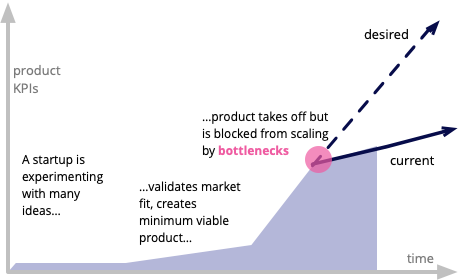Bottlenecks of Scaleups
A collection of articles on common problems startups face when scaling.

31 January 2024
Tim Cochran, Carl Nygard, Kennedy Collins, Keyur Govande, Premanand Chandrasekaran, Punit Lad, Rick Kick, Roni Smith, Sofia Tania, and Stefania Stefansdottir- Accumulation of tech debt; experiments and shortcuts are core components
- Constrained by talent and struggling to attract top technologists
- Friction Between Product and Engineering; Lack of trust and collaboration slowing down product growth
- Surging cloud and managed services costs outpacing customer growth
- Service disruptions; production incidents reduce reputation and revenue
- Onboarding; Too long for new hires to reach full effectiveness
Throughout Thoughtworks’ history, we’ve been partnering with startups to help them scale. We’ve worked with organizations at various stages in their development — from helping early-stage startups experiment, land on the right idea and create an MVP, to helping later-stage scaleups create the right technical platform and organizational structure for managing hyper-growth.
A typical scenario is a medium- or later-stage startup that has reached an impasse in its business. They might have an unreliable product, high costs, unproductive product delivery, trouble hiring the right staff or be stuck on new ideas to delight customers — affecting the growth of their company.
Frequently, we see that the underlying cause for these challenges is a bottleneck. As the company grew, it didn’t adjust its initial strategy to encompass the stress that scale would place on its people, processes and technology.
The bottleneck might not be new — bureaucracy, delays, business challenges and cost impact organizations of all stages — but as a company grows and its product takes off, what was once a small amount of friction becomes a limiting factor. As a company scales, these bottlenecks become major problems that require significant changes or investments to address.
Through extensive learnings from Thoughtworks scaleup teams and conversations with scaleup leaders about their scaling journey, we’ve identified the 11 different common bottlenecks listed above. For each bottleneck we are writing an article that digs deeper, looking at what led to the bottlenecks, what were the warning signs and what the solution is to get out of the bottleneck.
To help us discuss how bottlenecks form, we find it useful to think of a startup's journey in terms of four phases.
Phase 1
Experimenting
Phase 2
Getting Traction
Phase 3
(Hyper) Growth
Phase 4
Optimizing
The experience at Etsy
Etsy, an online marketplace for unique, hand-crafted items, has seen high growth over the last five years. Then the covid-19 pandemic dramatically changed shoppers’ habits, leading to more consumers shopping online. As a result, Etsy grew from 46.35 million buyers to 96.3 million buyers (208%) and from 2.6 to 7.5 million (288%) sellers.
The growth massively increased demand on the technical platform, scaling traffic almost 3X overnight. Etsy also had more customers for whom it needed to continue creating great experiences.
The foundational scaling work had started long before the pandemic. In 2017 Mike Fisher joined as CTO. He has a background in scaling high-growth companies, and along with Martin Abbott wrote several books on the topic, including The Art of Scalability and Scalability Rules. They collaborated with Thoughtworks to help them with their scaling program.
Etsy relied on physical hardware in two data centers in New Jersey, which slowed capacity increases and were an availability risk. Consequently Mike and his team initiated a program to move their many systems to the cloud. While the cloud migration was happening, Mike identified the product delivery process as being another potential scaling bottleneck, leading the organization to re-evaluate the effectiveness of their product planning and delivery processes.
